Related Research Articles
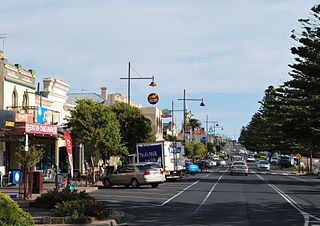
Portland is a city in Victoria, Australia, and is the oldest European settlement in the state. It is also the main urban centre in the Shire of Glenelg and is located on Portland Bay. In June 2018 the estimated population was 10,900, having decreased slowly at an average annual rate of −0.03% year-on-year over the preceding five years.

The Shire of Moyne is a local government area in the Barwon South West region of Victoria, Australia, located in the south-western part of the state. It covers an area of 5,481 square kilometres (2,116 sq mi) and in June 2018 had a population of 16,887. It includes the towns of Port Fairy, Koroit, Mortlake, Macarthur, Peterborough, Caramut, Ellerslie, Framlingham, Garvoc, Hawkesdale, Kirkstall, Panmure, Mailors Flat, Purnim, Wangoom and Woolsthorpe. It also entirely surrounds the City of Warrnambool, a separate local government area. It was formed in 1994 from the amalgamation of the Shire of Belfast, Shire of Minhamite, Borough of Port Fairy, and parts of the Shire of Mortlake, Shire of Warrnambool, Shire of Dundas, Shire of Mount Rouse and Shire of Hampden.
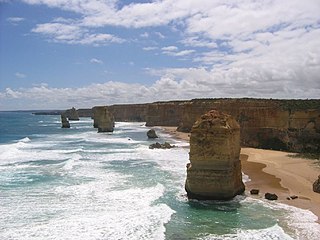
The Western District comprises western regions of the Australian state of Victoria. It is said to be an ill–defined district, sometimes incorrectly referred to as an economic region,. The district is located within parts of the Barwon South West and the Grampians regions; extending from the south-west corner of the state to Ballarat in the east and as far north as Ararat. The district is bounded by the Wimmera district in the north, by the Goldfields district in the east, by Bass Strait and the Southern Ocean in the south, and by the South Australian border in the west. The district is well known for the production of wool. The most populated city in the Western District is the Ballarat region, with 96,940 inhabitants.

Framlingham is a rural township located by the Hopkins River in the Western District of Victoria, Australia, about 20 kilometres (12 mi) north-east of the coastal city of Warrnambool. In the 2016 census, the township had a population of 158.
The Dhauwurd Wurrung, also known as the Gunditjmara or Gunditjamara, are an Aboriginal Australian people of southwestern Victoria. They are the traditional owners of the areas now encompassing Warrnambool, Port Fairy, Woolsthorpe and Portland. Their land includes much of the Budj Bim heritage areas.
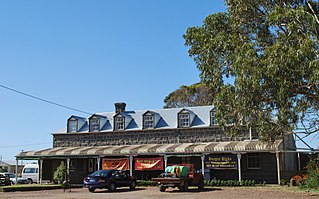
Yambuk is a town in Victoria, Australia.
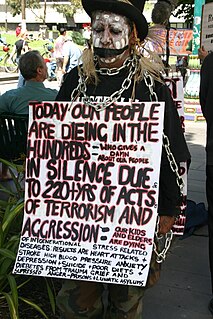
Djadjawurrung or Dja Dja Wurrung, also known as the Jaara or Jajowrong people and Loddon River tribe, is an Aboriginal Australian people whose traditional lands include the watersheds of the Loddon and Avoca rivers in the Bendigo region of central Victoria, Australia. They are part of the Kulin alliance of Aboriginal Victorian peoples. There are 16 clans, which adhere to a patrilineal system. Like other Kulin peoples, there are two moieties: Bunjil the eagle and Waa the crow.
The Convincing Ground Massacre was a massacre of the Indigenous Gunditjmara people Kilcarer gundidj clan by British settler whalers based at Portland Bay in South-Eastern Australia. It was part of the wider Eumeralla Wars between the British colonisers and Gunditjmara. Tensions between the two groups had been building since the establishment of the town as a whaling station some five years previously, however, around 1833 or 1834, a dispute over a beached whale caused events to escalate.

Lake Condah, also known by its Gunditjmara name Tae Rak, is in the Australian state of Victoria, about 324 kilometres (201 mi) west of Melbourne and 20 kilometres (12 mi) north-east of Heywood by road. It is in the form of a shallow basin, about 4 kilometres (2.5 mi) in length and 1 kilometre (0.62 mi) wide.
The Djab wurrung, also spelt Djabwurrung, Tjapwurrung, Tjap Wurrung, or Djapwarrung, people are Aboriginal Australians whose country is the volcanic plains of central Victoria from the Mount William Range of Gariwerd in the west to the Pyrenees range in the east encompassing the Wimmera River flowing north and the headwaters of the Hopkins River flowing south. The towns of Ararat, Stawell and Hamilton are within their territory. The Djab Wurrung Heritage Protection Embassy is located on a proposed highway duplication on the Western Highway south of Ararat. There were 41 Djab wurrung clans who formed an alliance with the neighbouring Jardwadjali people through intermarriage, shared culture, trade and moiety system before colonisation. Their lands were conquered but never ceded.
The Djargurd Wurrung are Aboriginal Australian people of the Western district of the State of Victoria, and traditionally occupied the territory between Mount Emu Creek and Lake Corangamite.
The Gulidjan, also known as the Kolakngat, perhaps originally Kolidjon, or Colac tribe are an Aboriginal Australian tribe whose traditional lands cover the Lake Colac region of Victoria, Australia. They occupied the grasslands, woodlands, volcanic plains and lakes region east of Lake Corangamite, west of the Barwon River and north of the Otway Ranges. Their territory bordered the Wathaurong to the north, Djargurd Wurrung to the west, Girai Wurrung to the south-west, and Gadubanud to the south-east.
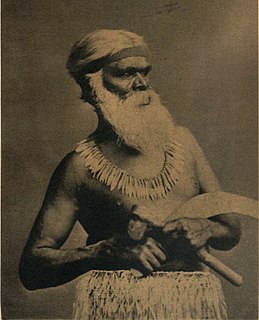
The Girai wurrung, also spelt Kirrae Wuurong and Kirrae Whurrung, are an Aboriginal Australian people who traditionally occupied the territory between Mount Emu Creek and the Hopkins River up to Mount Hamilton, and the Western Otways from the Gellibrand River to the Hopkins River. The historian Ian D. Clark has reclassified much of the material regarding them in Norman Tindale's compendium under the Djargurd Wurrung, a term reflecting the assumed pre-eminence of one of their clans, the Jacoort/Djargurd.

The Kulin languages are a group of closely related languages of the Kulin people, part of the Kulinic branch of Pama–Nyungan.

Aboriginal Victorians, the Aboriginal Australians of Victoria, Australia, occupied the land for tens of thousands of years prior to European settlement. Aboriginal people have lived a semi-nomadic existence of fishing, hunting and gathering, and farming eels in Victoria for at least 40,000 years.

The Kulinic languages form a branch of the Pama–Nyungan family in Victoria (Australia). They are:

Djadjawurrung is an Aboriginal Australian language spoken by the Dja Dja Wurrung people of the Kulin nation of central Victoria. Djadjawurrung was spoken by 16 clans around Murchison, the central highlands region, east to Woodend, west to the Pyrenees, north to Boort and south to the Great Dividing Range.

Wergaia or Werrigia is an Aboriginal Australian language in the Wimmera region of north-Western Victoria. The Wergaia language consisted of four distinct dialects: Wudjubalug/Wotjobaluk, Djadjala/Djadjali, Buibadjali, Biwadjali. Wergaia was in turn apparently a dialect of the Wemba Wemba language, a member of the Kulinic branch of Pama–Nyungan. The Aboriginal people were known as the Maligundidj, which means the people belonging to the mali (mallee) eucalypt bushland which covers much of their territory.
The Eumeralla Wars were the violent encounters over the possession of land between British colonists and Gunditjmara Aboriginal people in what is now called the Western District area of south west Victoria.
The Eastern Maar people are a group of Aboriginal Australian peoples whose traditional lands are in the south-western part of state of Victoria, Australia. It is a name adopted by a number of Aboriginal Victorian groups who identify as Maar, including Eastern Gunditjmara, Tjap Wurrung, Peek Whurrong, Kirrae Whurrung, Kuurn Kopan Noot and/or Yarro waetch people. They are represented by the Eastern Maar Aboriginal Corporation (EMAC), a land council.
References
- 1 2 Dixon, R. M. W. (2002). Australian Languages: Their Nature and Development. Cambridge University Press. p. xxxv.
- ↑ S20 Dhauwurd Wurrung at the Australian Indigenous Languages Database, Australian Institute of Aboriginal and Torres Strait Islander Studies (see the info box for additional links)
- ↑ Blake, Barry J. (2003). The Warrnambool Language: A Consolidated Account of the Aboriginal Language of the Warrnambool Area of the Western District of Victoria based on Nineteenth-Century Sources. Canberra: Research School of Pacific and Asian Studies, Australian National University.
- ↑ Clark, I. (1995). Scars in the Landscape: A Register of Massacre Sites in Western Victoria, 1803-1859. EBL ebooks online. Aboriginal Studies Press. p. 177. ISBN 978-0-85575-595-9 . Retrieved 12 July 2020.
- ↑ Clark, I. (1995). Scars in the Landscape: A Register of Massacre Sites in Western Victoria, 1803-1859. EBL ebooks online. Aboriginal Studies Press. p. 11. ISBN 978-0-85575-595-9 . Retrieved 12 July 2020.
- ↑ Dooley, G.; Clode, D. (2019). The First Wave: Exploring early coastal contact history in Australia. Wakefield Press. p. 30. ISBN 978-1-74305-615-8 . Retrieved 12 July 2020.
- ↑ Clark, Ian; Cahir, Fred (2014). "6. John Green, Manager of Coranderrk Aboriginal Station, but also a ngamadjidj? New insights into His Work with Victorian Aboriginal People in the Nineteenth Century". In Brett, Mark; Havea, J. (eds.). Colonial Contexts and Postcolonial Theologies: Storyweaving in the Asia-Pacific. Palgrave Macmillan. pp. 129–144. doi:10.1057/9781137475473_9. ISBN 978-1-349-50181-6 . Retrieved 12 July 2020. Whole e-book
- ↑ "Ngamadjidj Shelter". Grampians Point. Retrieved 12 July 2020.
- ↑ "Gunditj Wurrung". Youtube. Retrieved 21 January 2021.
- ↑ "Laka Gunditj Language Program". Gunditj Mirring. Retrieved 21 January 2021.
- ↑ "Corey Theatre Keeps Traditional Language Alive" Check
|url=value (help). BroadSheet. Retrieved 21 January 2021. - ↑ "Port Fairy Spring Music Festival mixes new and old". The Standard. Retrieved 24 January 2021.
- 1 2 3 "Eumeralla, a war requiem for peace". National Indigenous Times. Retrieved 8 May 2019.